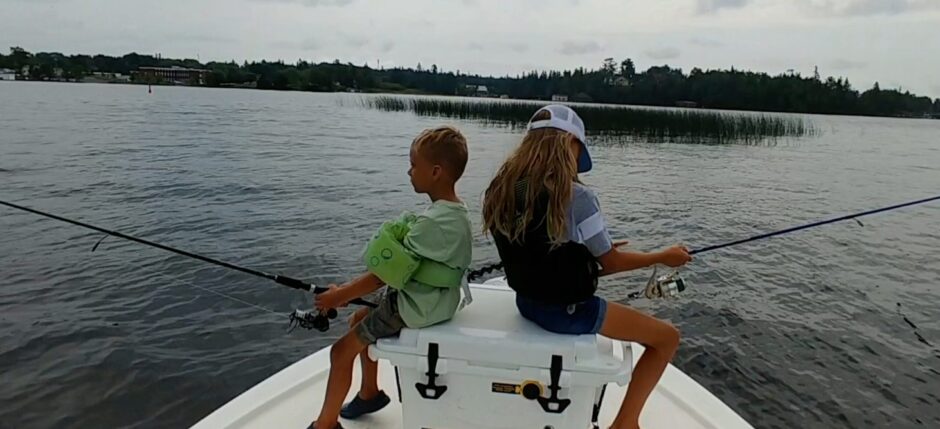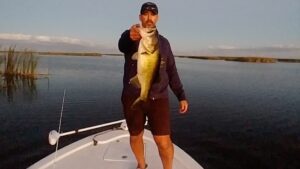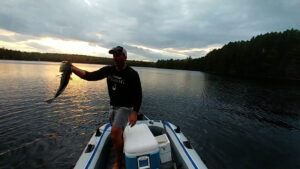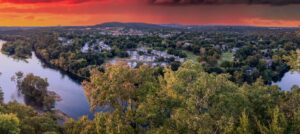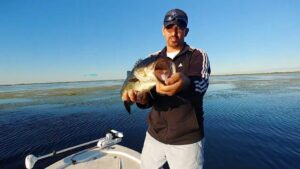Clear Water Lakes

There are plenty of lakes out there with very clear water. The clear water lakes tend to be harder to fish for most anglers, but that is usually because those anglers don’t know how to adapt to the clear water.
Some of the keys to fishing clearer water are using lighter line, using flourocarbon line or at least a fluorocarbon leader, fishing deeper and making longer casts. It’s also super important to fish during low light conditions such as early morning, in the evening and even at night. The fish can see you in clear water, so you need to understand how to make the adjustments to put these fish in the boat still.
Murky Water Lakes

There are plenty of lakes out there with murky water and they may not look great, but they are very productive fisheries. To have success on these lakes, some of the keys are to fish with brighter baits, use lures with rattles, fish shallower and on some bodies of water, the mid-day bite actually is better than in low light conditions.
Shallow Lakes

Shallow lakes usually limit the potential for big fish, but there are plenty of shallower lakes out there that still provide good fishing opportunities. Most shallower lakes are known as bass and bluegill lakes, however, up north, you may find northern pike, perch, crappie and other panfish. Out west, it could be trout. Either way, the shallower lakes may provide some decent fishing, but they are limited for trophy potential and they have a higher chance of a fish kill during the winter for the lakes that are up north. They also are known for having more vegetation because the light can penetrate through most of the lake.
Deep Lakes

The lakes with some deep water will usually give anglers some trophy potential. Now, every lake can be different and there are a lot of variables that go into whether a fishery will be good or not. However, it’s hard to grow huge fish in shallow ponds, so if you want to grow big fish, you need some big waters with some deep water. These deeper lakes have more potential for big fish, however, the better deep water lakes will still have plenty of shallow water in the lakes whether that’s from bays or just shallower water along the shorelines. The deep lakes with little to almost no shallow water will usually only be good for trout or even salmon. A good deep water lake with plenty of shallow water sections can have a wide variety of fish and lots of big fish potential.
Small Lakes

Small lakes are usually best for fishing with small boats or from shore. These smaller lakes often won’t have a boat launch and will usually have less fishing pressure. You may not have as much trophy potential on the smaller lakes, but you can enjoy some awesome fishing on some of the small lakes that don’t get as much pressure. Some states that offer a lot of options for fishing smaller lakes and Wisconsin and Minnesota. You have so many lakes to fish and so many of them get little fishing pressure. You can find some awesome fishing in places like this.
Large Lakes

The big lakes won’t always be good fisheries, but they do give us more options for more fish and bigger fish. The best lakes that produce awesome fishing are all bigger bodies of water. More water, more potential. It is that simple. If you are looking to target trophy fish, you should look at some of the bigger lakes out there.
Some of the Areas You Will Fish On Lakes
Bays

Bays are great for fishing in the spring and fall, however, some of the bigger lakes with have bays so big that they will fish more like a small lake within a lake and there can be quality fish in those bays all season long. Typically though, the bays will have more vegetation because they are shallower and a variety of fish will move into the bays as the waters warm up in the spring and early summer. Many fish will also spawn in the bays before moving out into deeper water on the main lake.
Docks

Docks are some of the best pieces of cover to fish on many lakes. You will usually find largemouth bass, some smallmouth bass, walleye and a variety of panfish such as bluegill, crappie, perch, rock bass and more. There are several other variables for whether or not a dock will be productive, but the docks are great places to fish on lakes throughout the open water season.
Drop-Offs

The drop-offs will almost always be better places to fish. The drop-offs are the closest points where a fish can go from deep water to shallow water. You will find fish relating to drop-offs from spring through fall and you will find a variety of different fish on the drop-offs.
Flats

Many lakes will have flats. Some of these flats will seem like they never hold fish and some flats may seem like the best fishing area of your life. The flats can be at any depth. It is basically a structure less part of the bottom, however, many anglers do consider the flats as a shallow water area. The shallow flats are usually good in the spring as water temperatures warm up. Bass, pike, muskie, walleye and panfish will use the flats, however, there are plenty of other variables that go into what type of fish will be there and when.
Points

Points are always good places to start if you’re not sure where to fish on a lake. Some of the points can be great, while some may not be good at all, however, some fish will usually use the points at some point throughout the open water fishing season. There are other variables that dictate whether or not the fish will be there, but points are definitely worth fishing and at times, they can provide some of the best fishing on the lake.
Reefs
Reefs are usually pretty big pieces of rock structure that can be found offshore. Most anglers think of walleye and smallmouth bass up north when they hear the word reef. This is because there are so many awesome bodies of water that have so many reefs as the main structure to fish when you go offshore. Smallmouth bass and walleye can often be found on these reefs, but you will also find other fish such as pike, muskie and a variety of panfish here too.
Rocks & Boulders

Almost all freshwater fish can be found around the rocky areas, however, some fish use the rocks a lot more than other fish. Smallmouth bass probably love the rocks more than any other freshwater fish because they love to feed on crayfish which are usually all around the rocks. Walleye love rocks too and lots of panfish will be found on the rocks.
Spillways, Creeks, Rivers, Inlets

The feeder creeks, rivers, small streams and basically any runoff water that feeds into a lake can produce some good fishing spots. Many lakes will not have any water flowing into it even after a heavy rain, however, there are plenty of lakes that do have some water that flows in and creates a current as it meets the lake. These spots can be awesome spots to fish depending on how much rain you get, what type of current is flowing in and what kind of depth you have where the water flows in. If you have some decent depth, you may find everything from bass to pike to muskie to catfish to panfish feeding in these areas.
Weeds

Weeds are great for a variety of fish, but some fish definitely like the weeds more. Largemouth bass and northern pike love the weeds. Bluegill and other sunfish do too. You can still find smallmouth bass, muskie and a variety of panfish too, so if the lake has some weeds, it is worth checking them out.
There are a variety of weeds or vegetation on a variety of lakes and some lakes with have a variety of vegetation within that same lake. Reeds, lily pads and cabbage are just some of the types of weeds you will see on lakes.
Wood

Wood can offer some very good fishing. On many of the lakes up north, you will have more of an outdoors feel to them with lots of trees lining the banks of these waters. When a strong storm hits and trees end up falling into the water, you get some great spots for holding a variety of fish. Some anglers also add fish cribs to lakes, which provides more opportunities to fish the wood. You are usually going to find wood along the shorelines of lakes, so look for wood that you can see above the water as well as wood that is under the water. Some of the deeper water wood will provide some of the best fishing. Walleye, bass and panfish love using the wood as cover. You will also find some pike, muskie, catfish and other fish here too.
